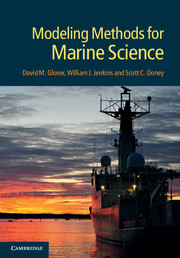Book contents
- Frontmatter
- Contents
- Preface
- 1 Resources, MATLAB primer, and introduction to linear algebra
- 2 Measurement theory, probability distributions, error propagation and analysis
- 3 Least squares and regression techniques, goodness of fit and tests, and nonlinear least squares techniques
- 4 Principal component and factor analysis
- 5 Sequence analysis I: uniform series, cross- and autocorrelation, and Fourier transforms
- 6 Sequence analysis II: optimal filtering and spectral analysis
- 7 Gridding, objective mapping, and kriging
- 8 Integration of ODEs and 0D (box) models
- 9 A model building tutorial
- 10 Model analysis and optimization
- 11 Advection–diffusion equations and turbulence
- 12 Finite difference techniques
- 13 Open ocean 1D advection–diffusion models
- 14 One-dimensional models in sedimentary systems
- 15 Upper ocean 1D seasonal models
- 16 Two-dimensional gyre models
- 17 Three-dimensional general circulation models (GCMs)
- 18 Inverse methods and assimilation techniques
- 19 Scientific visualization
- Appendix A Hints and tricks
- References
- Index
4 - Principal component and factor analysis
Published online by Cambridge University Press: 05 June 2012
- Frontmatter
- Contents
- Preface
- 1 Resources, MATLAB primer, and introduction to linear algebra
- 2 Measurement theory, probability distributions, error propagation and analysis
- 3 Least squares and regression techniques, goodness of fit and tests, and nonlinear least squares techniques
- 4 Principal component and factor analysis
- 5 Sequence analysis I: uniform series, cross- and autocorrelation, and Fourier transforms
- 6 Sequence analysis II: optimal filtering and spectral analysis
- 7 Gridding, objective mapping, and kriging
- 8 Integration of ODEs and 0D (box) models
- 9 A model building tutorial
- 10 Model analysis and optimization
- 11 Advection–diffusion equations and turbulence
- 12 Finite difference techniques
- 13 Open ocean 1D advection–diffusion models
- 14 One-dimensional models in sedimentary systems
- 15 Upper ocean 1D seasonal models
- 16 Two-dimensional gyre models
- 17 Three-dimensional general circulation models (GCMs)
- 18 Inverse methods and assimilation techniques
- 19 Scientific visualization
- Appendix A Hints and tricks
- References
- Index
Summary
‘From a drop of water,’ said the writer, ‘a logician could infer the possibility of an Atlantic or a Niagara without having seen or heard of one or the other. So all life is a great chain, the nature of which is known whenever we are shown a single link of it.’
Sir Arthur Conan DoyleSuppose you're looking for patterns or relationships in your data. For example, you may be trying to quantify the presence and distribution of certain water masses in a hydrographic section, or you may be looking for evidence and patterns of nitrogen fixation or denitrification in some nutrient data. Perhaps you're trying to find the best way to account for interferences from other elements (“matrix effects”) in your ICPMS data. You've gathered your data, maybe obtained from a cleverly designed experiment, or extracted from a hydrographic atlas or a collection of cruise data. The information you require lies within the relationships or correlations between the different properties or variables in your data set. But where (and how) do you look? If instinct leads you to look at the data covariance matrix, then your instinct is right! In this chapter we'll show you some techniques for extracting and analyzing this structure. We will start with some underlying basics that you'll need to understand these techniques, and we'll mention a few relatively intuitive approaches for analyzing data structure.
- Type
- Chapter
- Information
- Modeling Methods for Marine Science , pp. 75 - 119Publisher: Cambridge University PressPrint publication year: 2011



